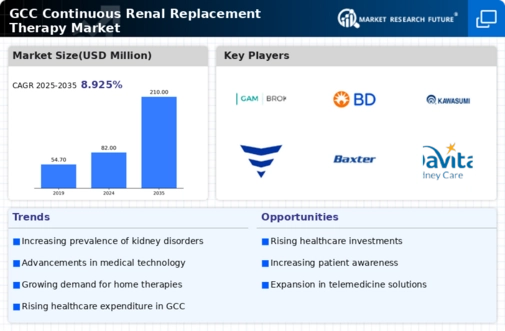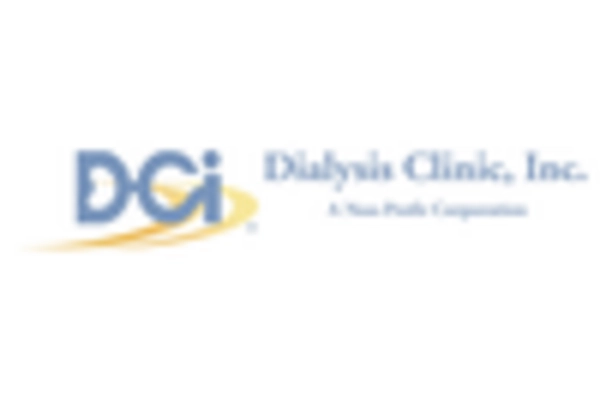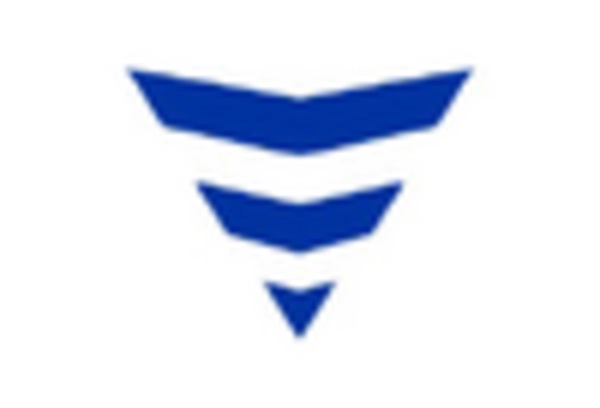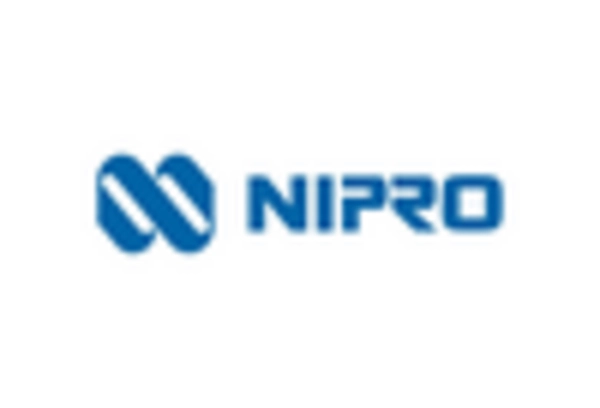Rising Awareness of Renal Health
There is a growing awareness of renal health among the population in the GCC, which is positively influencing the continuous renal-replacement-therapy market. Educational campaigns and health initiatives aimed at promoting kidney health are becoming more prevalent, leading to early detection and treatment of kidney-related issues. As individuals become more informed about the risks associated with kidney diseases, they are more likely to seek medical attention, thereby increasing the demand for continuous renal-replacement therapy. This heightened awareness is expected to contribute to market growth, as healthcare providers respond to the increasing need for effective renal care solutions.
Government Initiatives and Funding
Government initiatives aimed at improving healthcare infrastructure in the GCC region significantly impact the continuous renal-replacement-therapy market. Various governments are investing in healthcare systems to enhance the quality of care for patients with renal diseases. For instance, funding for dialysis centers and renal care units has increased, facilitating access to continuous renal-replacement therapy. In 2025, it is estimated that healthcare spending in the GCC will reach approximately $100 billion, with a substantial portion allocated to renal care. These investments not only improve patient access to necessary treatments but also encourage the adoption of innovative technologies in the continuous renal-replacement-therapy market, ultimately leading to better health outcomes.
Aging Population and Lifestyle Changes
The aging population in the GCC, coupled with lifestyle changes, is a significant driver of the continuous renal-replacement-therapy market. As the demographic landscape shifts, the number of elderly individuals susceptible to kidney diseases is increasing. Additionally, lifestyle factors such as poor diet, sedentary behavior, and rising obesity rates contribute to the prevalence of chronic kidney conditions. By 2025, it is projected that the elderly population in the GCC will account for over 10% of the total population, further escalating the demand for renal replacement therapies. This demographic trend underscores the necessity for effective continuous renal-replacement therapy solutions to manage the health of aging individuals.
Technological Innovations in Renal Care
Technological innovations play a crucial role in shaping the continuous renal-replacement-therapy market. The introduction of advanced dialysis machines and monitoring systems has enhanced the efficiency and effectiveness of renal replacement therapies. In the GCC region, the adoption of automated and portable dialysis systems is on the rise, allowing for more flexible treatment options for patients. These innovations are expected to drive market growth, as they improve patient comfort and reduce the burden on healthcare facilities. Furthermore, the integration of telemedicine and remote monitoring technologies is likely to facilitate better management of patients undergoing continuous renal-replacement therapy, thereby expanding the market's reach and accessibility.
Increasing Prevalence of Chronic Kidney Disease
The rising prevalence of chronic kidney disease (CKD) in the GCC region is a primary driver for the continuous renal-replacement-therapy market. Reports indicate that CKD affects approximately 13% of the adult population in GCC countries, leading to a growing demand for renal replacement therapies. As the population ages and lifestyle-related diseases become more common, the incidence of CKD is expected to rise further. This trend necessitates the implementation of advanced treatment options, including continuous renal-replacement therapy, to manage patients effectively. The continuous renal-replacement-therapy market is likely to expand as healthcare providers seek to address the increasing burden of CKD, thereby improving patient outcomes and reducing healthcare costs associated with advanced kidney disease.

















Leave a Comment